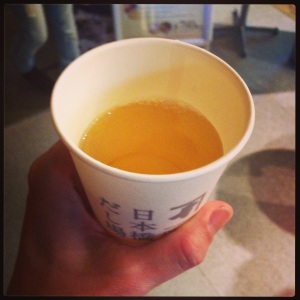On November 1st, I was lucky enough to participate in a Nihonbashi tour focusing on “Umami,” or the fifth taste, that is very common in Japanese. The 90-minute tour included discussion about nori, katsuobushi and dashi, and general panel discussion. It was coordinated by Japan Food Festa as part of a month-long celebration of Japanese food and culture.
I participated in the first tour of the day. We met at Mitsukoshi Department Store, one of the oldest in Japan, in downtown Tokyo. To start the tour, they described the importance of the Nihonbashi bridge (which has a huge highway running above it now so a bit of an eyesore). The bridge dates back to Edo period and this was one of the main merchant areas. Therefore, many of the oldest shops in Tokyo can be found here.
Our first stop was Yamamoto Noriten shop specializing in nori (seaweed) that was founded in 1849 during the Edo Era. The manager gave a brief presentation about the store and its history. We given samples of nori prior to grilling to get the taste of it. Then the nori was freshly grilled in front of us and we were given another sample. I enjoyed both samples. The first tasted light and “of the sea” while after grilling it, the flavors intensified. The store offers various types of nori for purchase as well as nori crackers and snacks. We sampled a few and I can’t wait to go back and purchase some!
Our second stop was Ninben which specializes in katsuobushi and was founded in 1699. Katsuobushi is the dried tuna that is thinly shaved to put on many Japanese dishes, found in furikake (condiment sprinkled on rice), or a key ingredient in dashi. The manager gave a presentation on the company and how katsuobushi is made. It’s a detailed process that results in a product that is only 14% water, one of the driest foods in the world. To be honest, it sounded like wood when you tapped it. The manager also demonstrated how they freshly shave the katsuobushi and had other tour participants give it a try. You definitely had to put some muscle in it! Luckily for us, they now have machines that will shave the katsuobushi so all you need to do is open a packet.
Attached to the store was a dashi bar. Yes, you heard right. A dashi bar. I made a joke beforehand that we were going to go to a dashi bar to sample and imagine my glee when I got to do just that! We were given the basic katsuobushi dashi to sample. Then we were instructed to add some soy sauce and taste again. Then salt and taste again. With each addition, I felt that the depth of flavors increase.
Once we completed the store visits, we headed back to Mitsukoshi Department store where we were able to view their tea ceremony room. Even with all my tea lessons, this was the first I had seen and/or used a traditional square entrance. The door was so samurais would have to remove their swords prior to entering the tea room and thus everyone became equals. Once in the room, we participated in a panel presentation and a Q&A regarding the products and the flavors of umami.
To conclude, Yukari of Food Sake Tokyo (amazing blog and travel book that is a necessity for any foodie traveling to Tokyo) summed up the tour and experience. She explained that Japan’s traditional washoku cuisine is up for UNESCO Intangible Cultural Heritage list and should be decided upon in December. If it receives the designation, it will help to preserve this traditional cuisine as well as provide greater options for foreign chefs to come, learn, and work in restaurants specializing in washoku. Once the presentation was complete, we were given a quick tour of the depachika (basement food floor of most major department stores). It truly is a foodie’s paradise with gorgeous bento boxes, pickles, wagashi, and more.
I want to thank Food Festa for putting on a great tour to delve a deeper into Japanese food and umami. I learned so much during this tour and it has made me more confident in understanding the process behind some of Japan’s most common ingredients.




